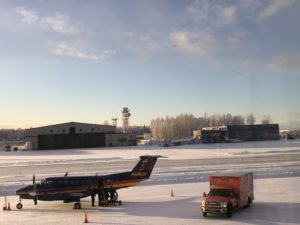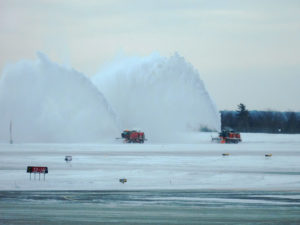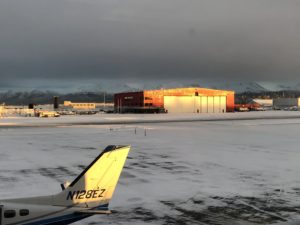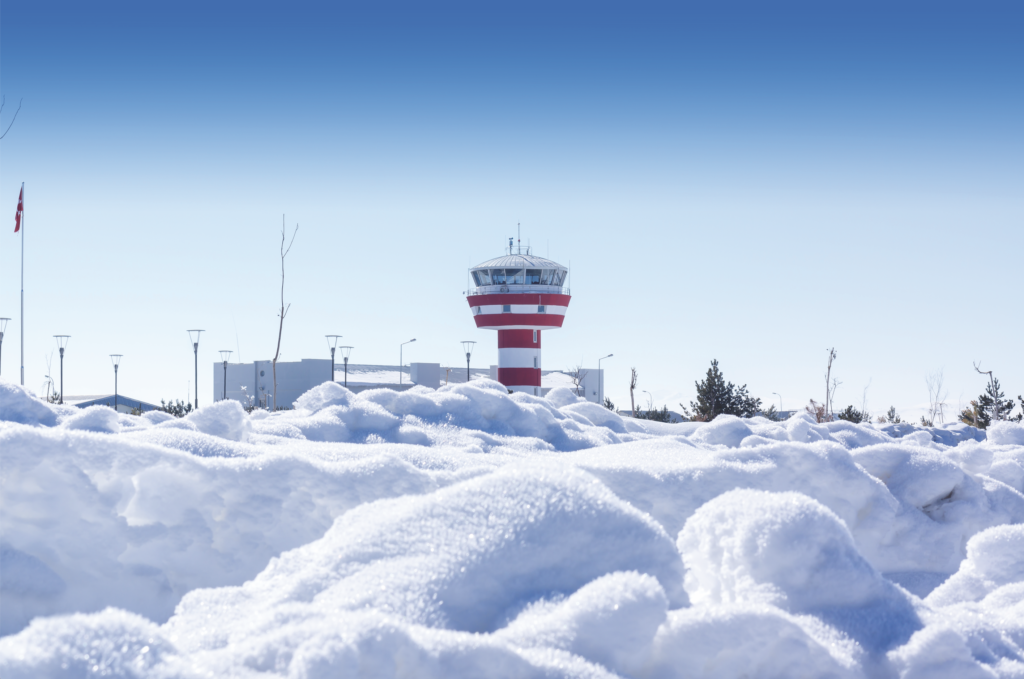For the staff of Alaska Aerofuel at Fairbanks International Airport winter comes early. Tim Hill, general manager at the Ross Aviation-owned FBO had already experienced his first major snowstorm of the season and seen lows of -33˚F (-27.5˚C) by early November.
Fairbanks, which is located in the Alaskan interior just 140 miles (225km) south of the Arctic Circle, must contend with a winter season that lasts eight months from October to May. But, it is not uncommon to see snowfalls as late as June, says Hill. The airport’s subarctic climate sees temperatures drop as low as -40˚F (-40˚C). Operating in this extreme cold creates a number of challenges for Hill and his team. He says, “One of the big things we have to do with our equipment is to run alcohol through the air systems to remove any moisture. Most fuel trucks run on air for the pumps and if there’s any kind of moisture in the system and you don’t do that, at 35 degrees below the trucks aren’t going to pump.”
Hill also relies heavily on industrial heaters to warm up components on aircraft left standing in the cold. “We use the heaters to pre-heat engines and auxiliary power units prior to starting them,” he says.
Equipped for winter
Before the winter season Alaska Aerofuel also swap out the diesel used to power their equipment with a cold weather alternative. “We use a diesel with a freezing point of -54˚F, if we don’t do that there’s a good chance the diesel will start to gel and if that happens the equipment won’t run.”
Around 300 miles (480km)south of Fairbanks in Alaska, another subsidiary Ross Aviation FBO, Great Circle Flight, operates out of Anchorage International Airport. While prone to less extreme cold than Fairbanks, Anchorage’s coastal location means it experiences more high-pressure systems, which results in more snowfall events than its drier, northern counterpart.

“We are pushing a lot of snow around while at the same time trying to serve aircraft,” says Laura Charon, Great Circle’s area vice-president. “The priority is to keep the ramps and the sidewalks clear.”
To do this the FBO relies on a mix of heavy equipment and manpower. “We use loaders to do the heavy lifting,” says Charon. “After that we use trucks outfitted with ploughs to pick up leavings. Then it’s just a lot of good,
old-fashioned shoveling.”
When they know a snowstorm is coming the FBO has a set of protocol to prepare for the event. “We try to ensure as many aircraft as possible are inside the hangar,” says Charon. “We’re also really focused on keeping a tidy ramp and tidy walkways so there’s nothing the plows can run over. Also, we’re calling in extra staff because we know we’re going to need them for ploughing and de-icing operations.”
Many of these operations are carried out in darkness since Anchorage has just five and a half hours of daylight at the height of winter. In Fairbanks it’s less than 4 hours. “We use a lot of head lamps,” says Charon. “It’s also part of our process for getting ready for winter to make sure that all our building lights, ramp lights and the lights on the machinery are fully serviced.”
Ice accretion

While snowstorms and extreme cold are a constant challenge for staff in northern-latitude FBOs, the worst winter weather phenomenon to deal with is freezing rain. For aircraft hit by freezing rain in flight the impact can be fatal, says Larry Jorash, vice-president of operations, integrations and safety at Ross Aviation. Freezing rain can accumulate behind the wing’s leading edge, which usually acts as a protective barrier for the engine. From there it can enter the engine and potentially stall it. “Pilots always pay particular care not to fly in those conditions if they can determine it in the forecast,” says Jorash.
Meanwhile, on the ground “team members have to pay attention, because some precipitation can make the ice on the airplane appear invisible,” says Jorash. Heated de-icing fluid can be applied to aircraft to remove any ice accumulations. Pilots can also request to have an anti-icing treatment applied which helps to ensure the wing stays clear during flight.
Freezing rain is not just a hazard for the aircraft, it also compromises runway operations. Unlike snow, which if left in place can often form a reliable surface for landing and take-off, freezing rain is treacherous to land on and has to be removed. Terry Townshend runs his own Canada-based winter weather consultancy for airports, Townshend Technical Services and believes that removing freezing rain from the runway is far harder than clearing snow. He says, “It accumulates very quickly creating an unbroken skin of ice across the surface of the asphalt.
“This means a tremendous amount of chemical energy has to be used to get through it.”
Airports can save a lot of resources if they are able to predict the freezing rain event before it happens and can use specialized sprayers to apply a layer of liquid chemical on to the runway surface. Spraying machines have an electronic control that matches “the application of the chemical to the forecasted precipitation rates,” says Townshend. Using too little chemical can result in the freezing rain adhering to the surface, whilst using too much liquid chemical “makes the surface slippery,” he says.
Over application of solid chemical can also cause unwelcome side-effects, he adds, especially in extreme cold weather locations. “After snowstorms it’s common to have drifting snow. Usually, the snow will blow over the runway but if you’ve got solid chemical left over on the surface still absorbing moisture the chemical will catch the drifting snow and you get snowdrifts building up very quickly.”
To avoid this side-effect the application rates of the spraying machines are also synchronized to adapt to the speed at which the machine is moving over the surface. If the freezing rain event is not predicted in time, a larger amount of solid chemical is applied in a localized way to erode through the ice skin. “The concentrated chemical applied in the one spot acts like a kind of drill,”
says Townshend.
Once the skin has been “drilled”, liquid chemical is sprayed into the hole to break up the surface further. According to Townshend it is important to note that the chemicals used for
de-icing the runway surface are very different in nature to the ones used for de-icing aircraft. This is because the requirements in the two cases are not the same.
“Glycol- or ethanol-based chemicals used for de-icing aircraft are designed to be slippery, whereas the chemicals used on the ground are designed to provide good friction between the aircraft tires and the runway,” says Townshend.
Repeated thaws

Ground-based chemicals include sodium- and potassium-based products and nitrogen-based products – most often urea – for the solid chemicals. Investing in these products and the machinery needed to apply them is expensive, especially for remote northern airports, which are usually small and under resourced. The effects of climate change are also stretching the scant resources of smaller airports even further. “The traditional method of maintaining gravel runways during winter at these northern airports has been to allow a thin accumulation of snow to build up on the surface. Once frozen in place, it provides a reliable surface,” says Townshend.
However, if the snow thaws and then refreezes the surface is no longer tenable. “Because instead of a crisp layer of snow you’ve now got ice,” he adds. This thawing and refreezing is happening more and more frequently because of climate change.
“It used to be the case that the standard practice for airports within the Arctic region was to allow this thin accumulation of snow on the runway. So, pilots flying there would see a completely white surface. But because of climate change many of these airports have had to change their modus operandi. The policy now is to plough down to revealed gravel.”
The extra resources required to do this are making the jobs of FBOs and airports operating in these regions harder. But running an airport throughout the bitter cold and long nights of the Arctic winter was never going to be easy. And the men and women who do it seem up to the challenge.
To a question about how many days in the winter Fairbanks is shut down by the weather Tim Hill is unequivocal. “We don’t ever shut down,” he says. “The funny thing is that those days when it gets down to 40 degrees below are some of the prettiest days you’ve ever seen. Clear blue skies – just very cold.”






